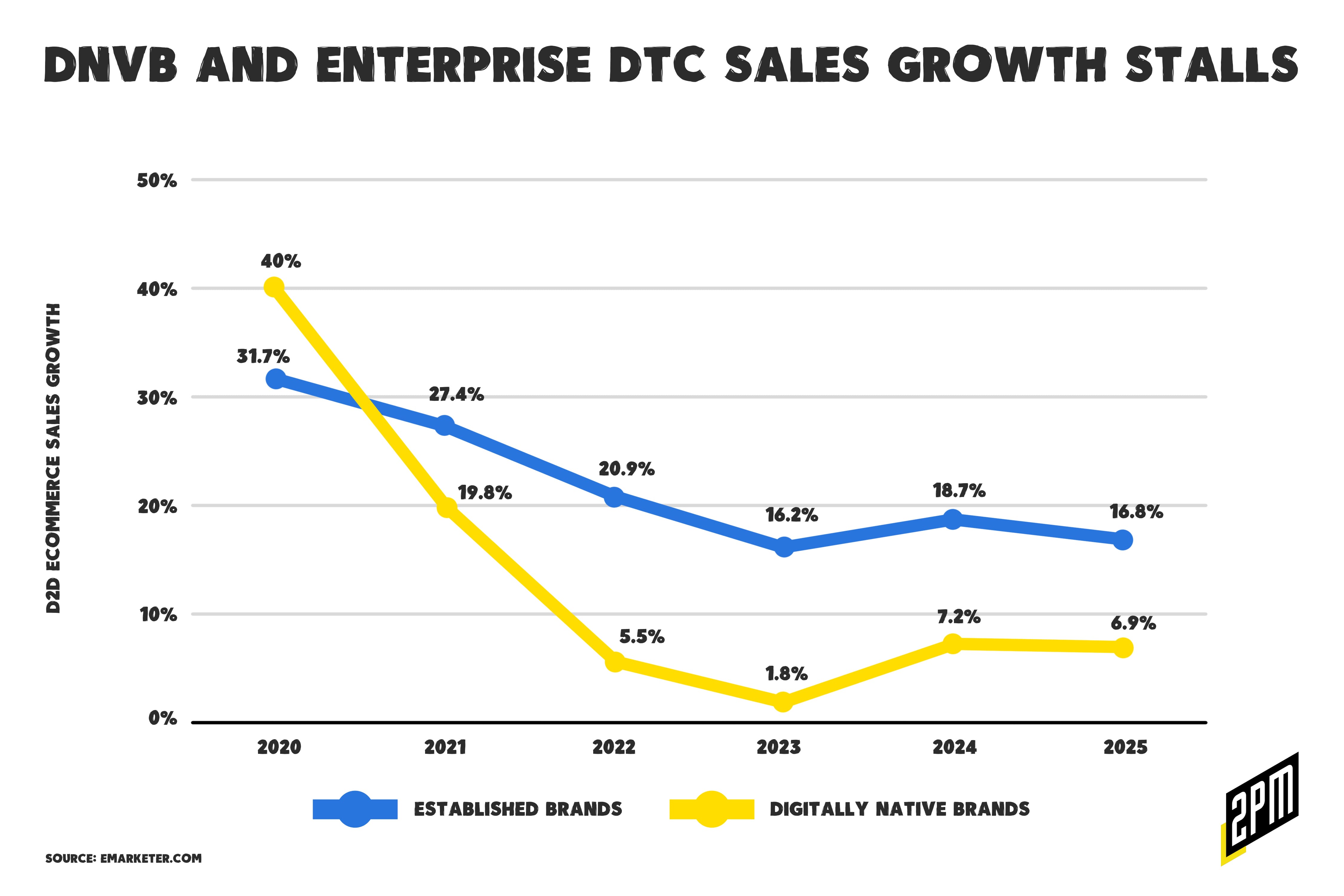
The DTC model was a game-changer for retail. But the category’s three letter moniker won’t be remembered for the brands that came from that forgone era. Data suggests that it will be remembered as a media or advertising strategy. There is a precedent for this.
Google, Wikipedia, and other sites still suggest that the phrase “direct-to-consumer” and its shorter-form catchphrase are referring to a “business model focusing on e-commerce of a single product category” or a sales channel where the original equipment manufacturer sells directly to the consumer (instead of using traditional wholesale channels).
The DTC era marked a pivotal moment in the way businesses connect with their audiences. This evolution, initially sparked by pioneering platforms like Shopify and BigCommerce in 2007 and 2009 respectively, now sees the moniker pivoting from the exclusive domain of retail and towards other industries adopting the acronym. Today, the media and advertising sectors are the ones stealing the search traffic for DTC news.
The journey of the three letter acronym, from one meaning a nascent brand retail strategy to one meaning a broad-based approach impacting retail, advertising, and media reflects a deeper change in consumer behavior. In eCommerce, DTC is less of a category and more of a function. In media, DTC is entering the cycle that harkens back to the 2009-2014 years of online retail. Here is what I earlier published on this seemingly forgone era:
The Direct-to-Consumer Brand era brought about a significant change in retail dynamics. Brands like Figs and Warby Parker exemplified this era by cutting out intermediaries and connecting directly with consumers. This model, highlighted by the rise of Shopify, allowed for greater control over brand messaging, customer experience, and product quality. The DTC era highlighted the importance of eCommerce, digital marketing, and consumer data analytics, making it a pivotal period in the evolution of modern retail. But few retailers mastered the economics required to become a durable brand.
The pandemic further exposed the vulnerabilities of the DTC model. Many DTC brands, with high operational costs and low savings, struggled with diminished consumer demand and supply chain disruptions. This led to significant downsizing of companies such as Away, Everlane, Casper, and others. Post-pandemic, we’re witnessing a shift in the DTC landscape. Entrepreneurs and investors are reevaluating the model, seeking a balance between the aspects that worked and those that didn’t. The focus is now on sustainable growth, effective customer engagement, and prudent financial management.
Fueled by Facebook and Google advertising spend, that DTC era democratized the market for small and medium-sized brands. Shopify’s platform, among others, played a crucial role in this revolution, allowing brands to sell directly to their consumers and bypass traditional middlemen that were known to block entry, at the time. This model thrived on the back of digital advancements and a growing consumer preference for personalized, direct brand interactions. It is in decline.

But prior to the decline, the periodic spikes in Google Trends for “d2c” are testament to this model’s growing resonance with the public, highlighting key moments of technological adoption and consumer shifts towards more personalized shopping experiences.
The recent strategic move by ESPN to launch a direct-to-consumer version by fall 2025 underscores the shift away from DTC’s hold on physical product brands, moving beyond retail to capture media and advertising realms. This approach, aimed at reaching an audience increasingly disenchanted with traditional cable bundles, represents a broader industry shift towards offering content and products directly to consumers. The collaboration among giants like ESPN, Warner Bros. Discovery, and Fox Corp. to bundle sports content into a new streaming service exemplifies their need to meet the modern consumer’s demand for direct, personalized content consumption. Ironically, it’s a demand that retail brands helped normalize for media companies.
While media is headed away from omnichannel and towards DTC, the retail sector has increased its focus on omnichannel strategies, as highlighted in recent analyses. The convergence of physical and online selling, accelerated by the pandemic, has led to significant investments in technology that enhance the customer experience across all touchpoints. Innovations such as augmented reality fitting rooms and interactive in-store displays are not merely enhancements but fundamental shifts in retail strategy, blurring the lines between eCommerce and physical stores.
Yet, this shift towards a more integrated approach to product retail comes with its set of challenges and criticisms. Concerns over scalability, sustainability, and consumer privacy are increasingly prominent. The model’s reliance on continuous consumer engagement and data collection for personalized experiences raises ethical questions. Moreover, for smaller brands, maintaining growth without compromising on quality or customer experience presents a significant challenge.
For product retail: sustainability, transparency, and the protection of consumer privacy are set to become central to consumer choices and, consequently, brand strategies. For media companies venturing into DTC, the creation of value will extend beyond content to encompass interactive and personalized experiences, crucial for attracting and retaining a modern audience. The trajectory of DTC media strategies will likely be defined by a delicate balance between leveraging technological innovations and addressing cost considerations.
The evolution of the DTC model reflects a broader narrative of change, from its early days in retail to its current embrace by media and advertising sectors. This shift is indicative of deeper societal changes and technological advancements. As the landscape continues to evolve, the adaptability and appeal of the DTC model remain clear, promising new opportunities and challenges for businesses aiming to connect directly with their consumers. The future of DTC lies in its ability to innovate while remaining mindful of value creation and proper unit economics, ensuring a sustainable and consumer-centric approach to business.
By Web Smith | Edited by Hilary Milnes with art by Christina Williams
